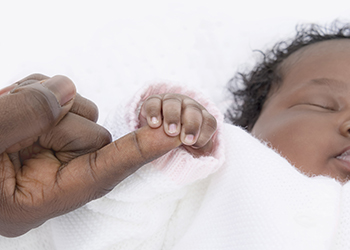Conversations Can Stop Sleep-Related Infant Deaths

There are a lot of frightening statistics surrounding infant deaths: more than 3,000 babies die suddenly and unexpectedly every year; black babies are dying at twice the rate of white babies; and sleep-related deaths have stopped declining.
As frightening as these numbers are, they’re also numbers that can be changed. That’s why, in this article, we want to spend less time talking about the numbers and more time talking about the actions that can help us start improving birth outcomes today.
According to the Founder of the Global Infant Safe Sleep Center, Stacy Scott, PhD, MPA, improving conversations with mothers and caregivers around safe sleep practices is one of those actions. After all, since sleep-related deaths are largely preventable, education can change outcomes. And conversations are at the heart of that education.
“Having successful conversations isn’t always easy,” says Scott, “especially when we remember that every mother comes with her own beliefs and lived-experience. But if we approach these conversations with realistic and relevant advice, and if our message is defined by sincere concern and genuine compassion, our advice is more likely to stick.”
Leveraging Scott’s advice can help transform the conversations happening between mothers and health professionals every day. To help inspire those efforts, Scott and a team of experts compiled a list of tactics and examples to support infant safe sleep conversations. Importantly, each of these strategies addresses actual questions posed during a recent webinar on this topic, which means each strategy responds to a real-life example from health professionals across the country.
Example One: Adamant, Longtime Bed Sharer
What can you say to a parent who is adamant (even after discussing safe sleep education) that the baby should sleep with her in the bed? This is what she has done with her other children and she wants the baby close to her.
- Tactics: Acknowledge her desire to continue to do what she believes is best for her other children. Then explain that we get new research all the time and, each time we study bed sharing, we find that there is a high chance of dying from sudden infant death syndrome (SIDS) or suffocation. This does not mean that every baby that shares a bed with their parent will die; it just means the chances are high and we are trying to prevent such tragedies.
- Sample Response: “Okay, I know all your babies slept with you in the past and thank goodness they all survived. I respect your decision. So, the question is, why am I asking you to do something different with this one? Because I am concerned. I have seen situations, for instance, when siblings jump in the bed with the mom and baby. Then, during the night they have laid on top of the baby and the baby died. There have been situations when pillows or blankets on an adult bed have caused babies to suffocate. Let me go over some safe sleep practices for you to consider…”
Example Two: Co-sleeper by Culture
I work with a lot of immigrant families and co-sleeping is a cultural practice for many of them. How do we remain culturally sensitive and still convey information regarding safe sleep?
- Tactics: Ask open ended question about their plans and circumstances and acknowledge where families are in terms of their beliefs and plans. This provides an opportunity to share the evidence that we know, then discuss risk reduction for behaviors families are willing to adopt. When we do this, we can support their understanding, provide an opportunity to discuss the advice or expectations coming from their family, and uncover questions they have around practices they may not be familiar with or are uncomfortable with. Using a strength based approach, we can identify the caregivers’ practices and behaviors that will reduce the greatest risks.
- Sample Response: “So, tell me where do you plan to put your baby to sleep? Does your baby normally sleep with you? Is that what many of your family members do? I see, well I would just like to share some information about some things we have discovered about babies and their sleep environment…”
Example Three: Bed Sharer for Perceived Sleep Benefits
What do you say to a mom who says, “my baby can’t sleep by herself in her crib/bassinet but sleeps when she is with me in bed”?
- Tactics: Acknowledge, as always, the frustration with not getting a good night’s sleep; then explain that persistence pays off. Parents should continue to try to encourage a separate sleep surface and place the bassinet close to the bed, within arm’s reach, so they can still comfort the baby.
-
Sample Responses:
- “I understand; what baby would not like to sleep close to their mother? I am sure you are right about her sleeping better with you, but the concern I have is for her safety. You may not know it, but an adult bed is not the safest place for a baby to be. Here’s why…”
- “Trust me if you start putting her back in a safe sleep environment, she may be a little fussy at first but she will get used to it. And you won’t have to fight with her when she gets older and you want her to sleep in her own bed!”
Example Four: Hospital Bed Sharers
What do you suggest when we find parents sleeping with their babies in the hospital more than once, even when educated about safe sleep?
-
Tactics:
- Ask the parent what prevents them from following the guidelines, then acknowledge their feelings and perceptions. Use teach and reteach and be persistent. Explain that learning how to sleep on a separate sleep surface and in supine position begins at the beginning. This is why it is important to practice from the start, in the delivery hospital. Remember to document all education and conversation.
- Additionally, consider finding some true-life stories about the negative impact of bed-sharing, particularly the ones that have happened in the hospital setting. Search the headline online. It is a scare straight tactic, but it can save a baby’s life.
-
Sample Responses:
- Consider asking, “Did you unintentionally fall asleep with the baby in your arms?”
- Sharing your hospital policy around safe infant sleep position might be helpful. For example, tell them, “I will need to awaken both of you to ensure the baby is in a safe sleep position and environment while in the hospital. We hope this will be your plan once you are home.”
Looking for more conversational tactics to address safe sleep? Request a PDF of all Q&A from our recent webinar: Improving Infant Safe Sleep Conversation, Strategies for Helping Families Adopt Safe Sleep Habits. Or, click here to view the recorded webinar.
